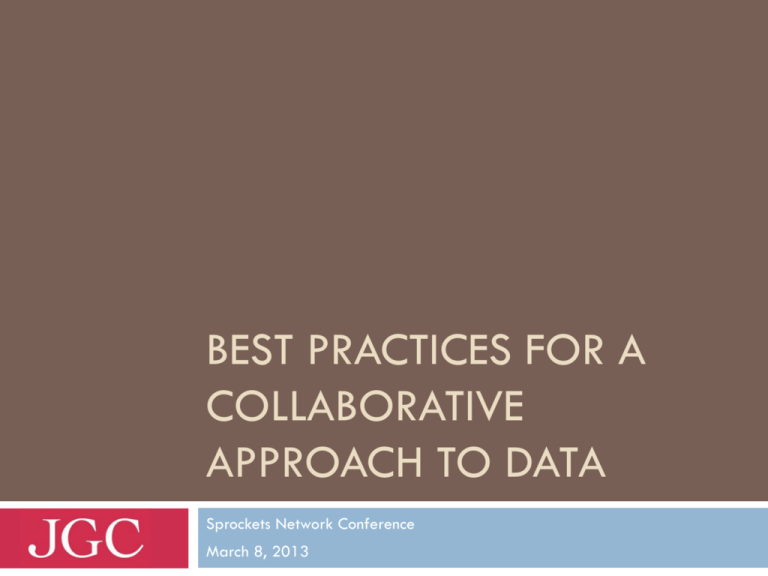ECE Linkages Project
advertisement

BEST PRACTICES FOR A COLLABORATIVE APPROACH TO DATA Sprockets Network Conference March 8, 2013 The role of data You are here Ensure Access Maintain an Effective Governance Structure Integrated Data System Supports all A/S system functions Engage in Strategic Communication Raise and Manage Resources Provide Support to Improve Program Quality Improved Outcomes For Youth The youth sector School Family Religious Institutions After School Program Youth Summer Programs Health Services Social Services Neighborhood Integrated data systems A set of shared capacities and technologies that enables the collection, analysis, and utilization of information about youth and programs Capacity Technology Data System What Integrated Data Can Add Person After School Program Daniel X Maria X Jasmine X Ben X Victor How many students attended a particular after school program? • 80% of students participated in the after school program What Integrated Data Can Add Person After School Program Youth Leadership Program Daniel X Maria X X Jasmine X X Ben X Victor Parent Education Class English Learner MCA Scores X Yes Proficient X No Advanced No Proficient Yes Below Basic Yes Far Below Basic • 80% of students participated in the after school program • 50% of students in the after school program also had parents in classes • English learners were least likely to be in leadership programs • Students in more than one program were more likely to score proficient or above Components of a data system Guiding principles Framing questions, data use agreements, stakeholder buy-in Technology MIS, data aggregation Data analysis and use Data collection, data analysis, data dialogue, strategic communications, action The Youth Data Archive • Looks at youth data across agencies and settings • Links individual-level data from partners to answer shared questions about youth served in common • Is driven by the questions of community members to inform policy and programmatic changes YDA’s guiding principles JGC is neutral third party Community partners own their data User-focused approach to developing questions, interpreting & presenting findings Long-term commitment to community partners—a design/build/revise approach Focus on actionable knowledge, proactive responses and community capacity building YDA data School districts – school attendance, achievement scores, discipline Program providers – OST program attendance Public agencies – child welfare, probation, Youth survey data – school climate, health All data have to be individually identified to be linked across agencies The YDA process PLANNING ANALYSIS / EARLY REPORTING ACTION / DISSEMINATION Conduct Analysis Disseminate findings to the broader field JGC STAFF Produce Preliminary Fact Sheet Transfer Data Identify Research Topic COMMUNITY PARTNERS Create Research Questions Share / Review Internally Discuss Findings & Refine Use analysis to improve services & develop policy Case study: Community schools Five schools in Redwood City, CA, that provide wrap-around service to students and families Questions: What are the participation patterns in services and combinations of services at the community schools? What are the relationships between service participation and student outcomes? Data and analysis Linked data on 250 programs and services for youth and families to school data Extended Learning Family Engagement • After school programs • Parent leadership • Summer/Intercession • Parent education programs classes • Youth leadership • Parent volunteer opportunities • Home-school communications • Family social events Support Services • Counseling • Family social support Communicating the data Annual cycle of: Discussion of initial analysis Presentations to school board and funder “Data talks” with the site coordinators Analysis findings and action Increasing participation over time, with the majority of students accessing multiple types of services Actions: Parent leadership and goal setting, program targeting, improving MIS Family engagement linked to ELD scores, especially combined with extended learning Actions: Policy to support more community schools, professional development on family engagement, more research Challenges to shared data Technical– incomplete, inaccurate, missing data; insufficient capacity Organizational—leaders’ buy in & advocacy; churn; regulatory hurdles Political—trusting university-based researchers, trusting each other Discussion questions What are the opportunities you see for using shared data in your organization? In the Sprocket network? Beyond? Who are the stakeholders in your data system? How can we engage them? What are some possible guiding principles for working together on shared data? What challenges do you anticipate as we continue building a shared data system in Saint Paul? How can those challenges be addressed?







